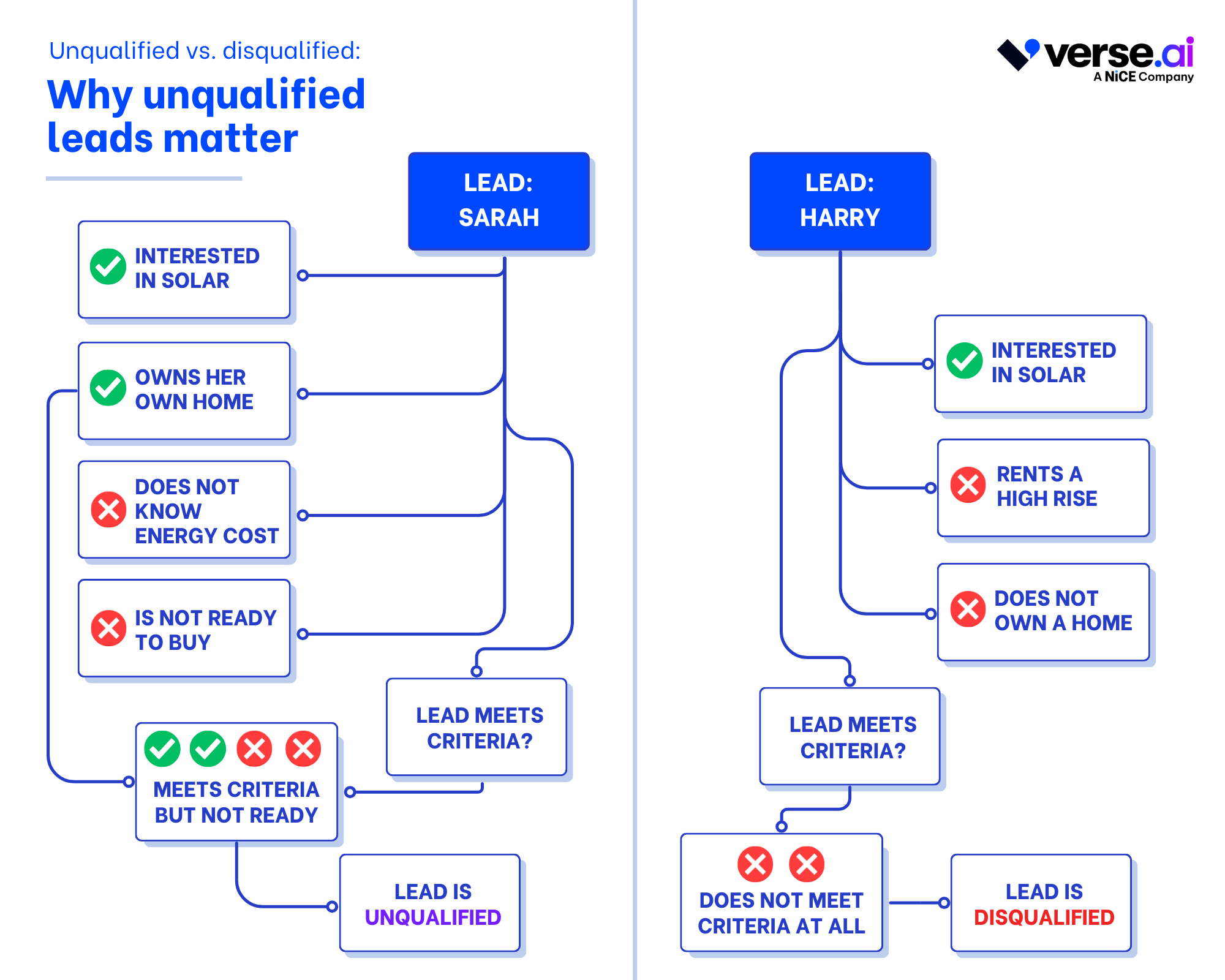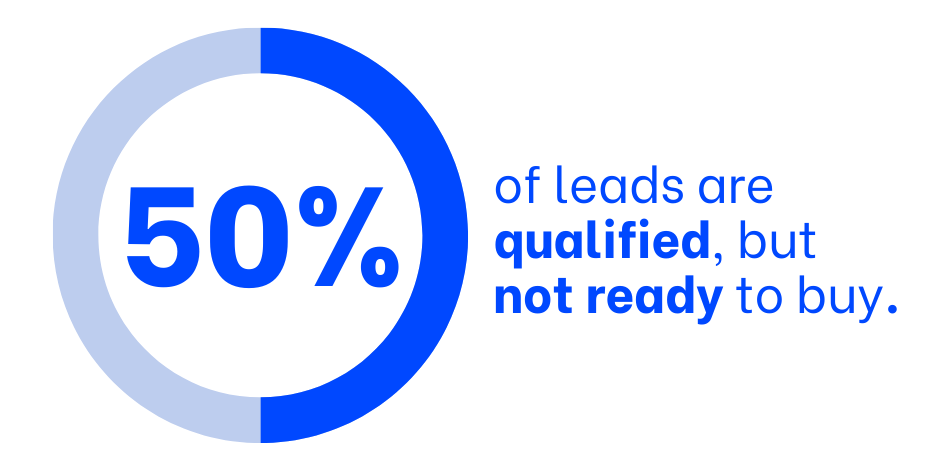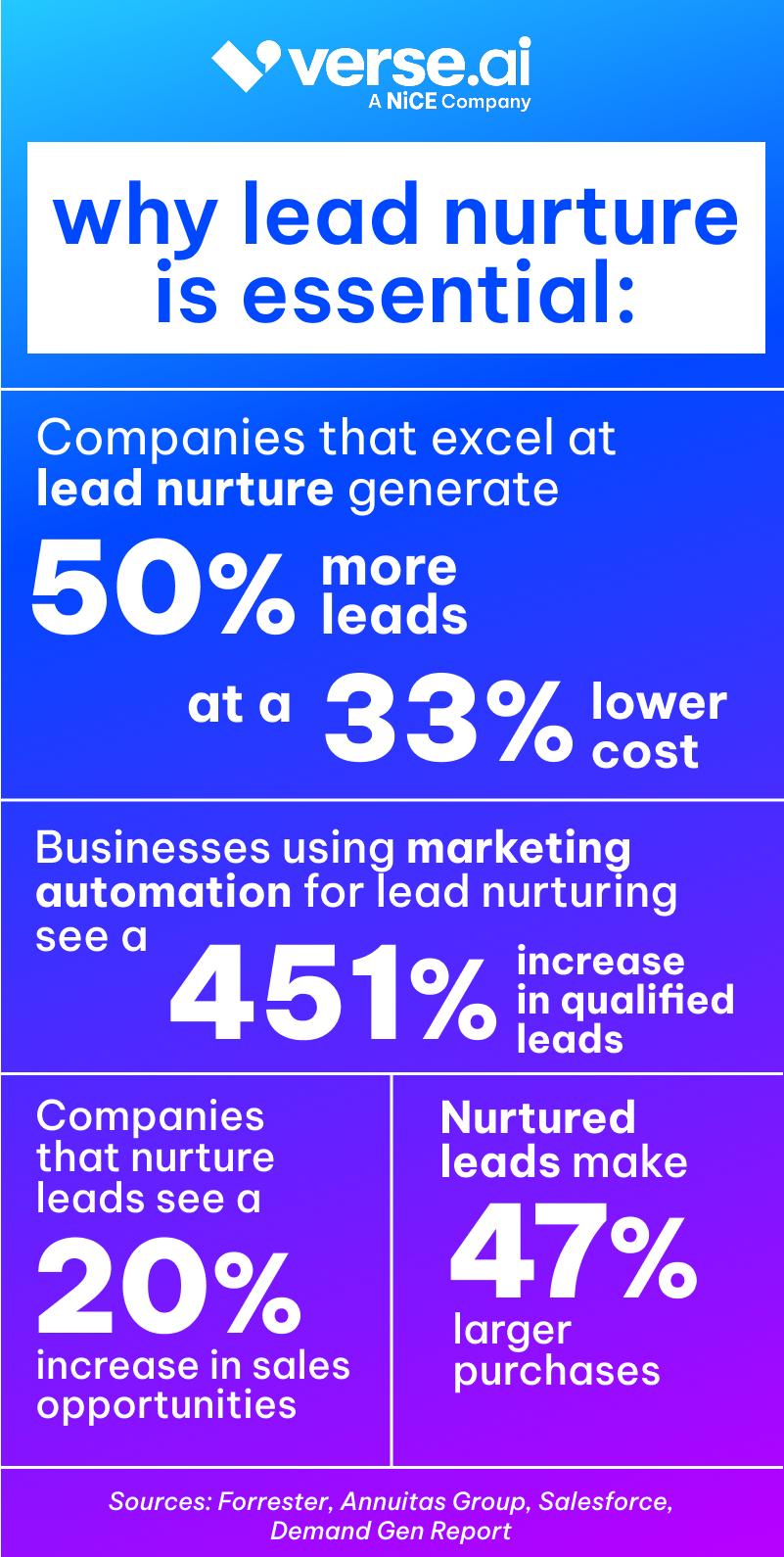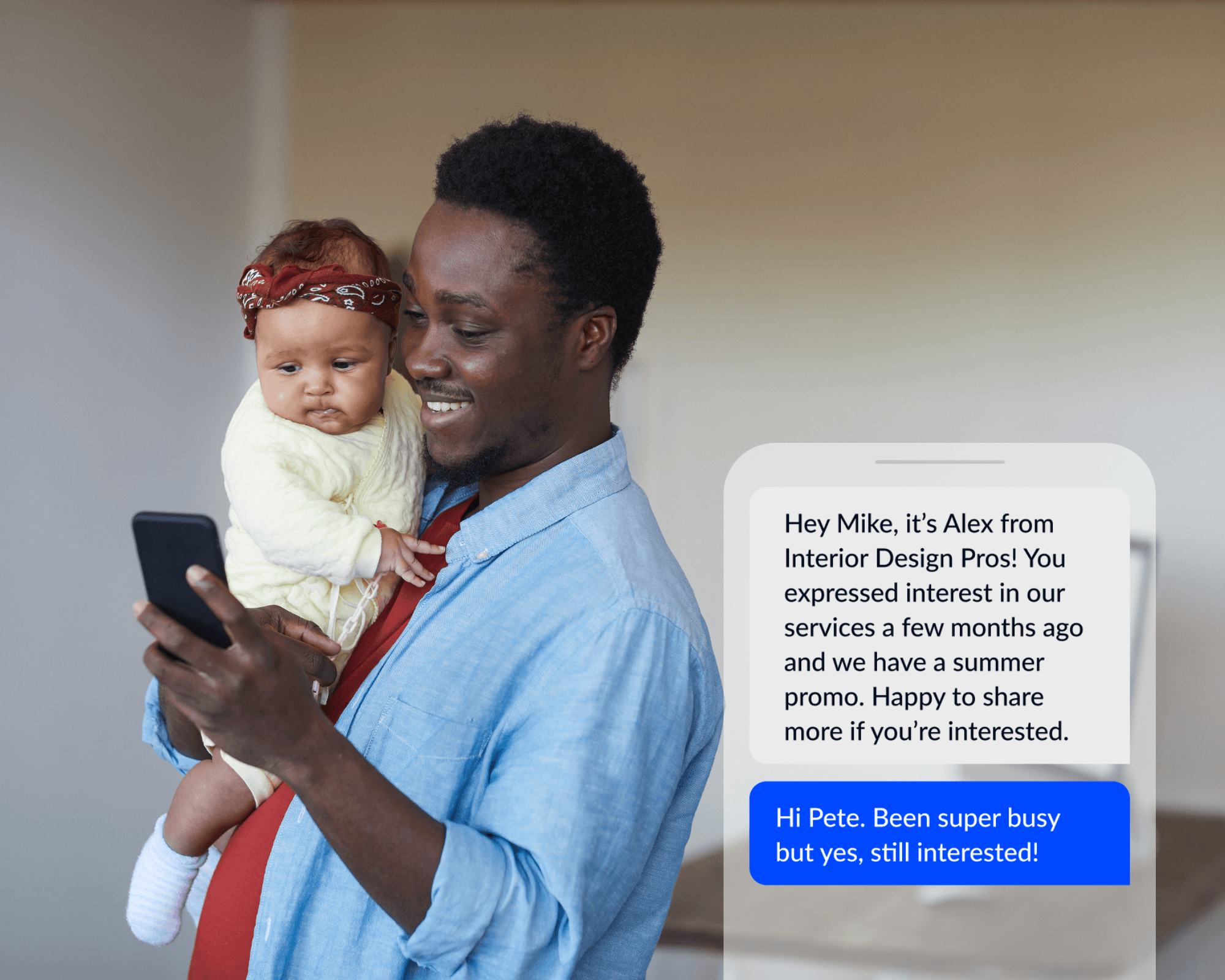Let’s face it: most leads are not ready to buy. It’s estimated that up to 96% of leads are not ready.
While every marketer and revenue leader wants to make the most of their lead generation budget, not everyone has a strategy in terms of unqualified leads.
There’s more to lead generation than just passing qualified leads to sales. The most effective lead generation strategies include a focus on unqualified leads: leads that aren’t ready now, but could convert down the line.
Depending on the industry, unqualified leads can make up a huge percentage of your current database—they can become a revenue driver, but it requires your team to make the right moves.
Unqualified leads are crucial to unlocking the greatest potential in your lead database, but many teams struggle with how to handle unqualified leads. Though these leads can still convert, it’s a challenge to effectively engage, re-qualify, and convert previously unqualified leads.
In this blog, we’ll reveal 7 common mistakes when it comes to unqualified leads, and clarify how to handle unqualified leads through effective lead nurture and re-engagement strategies.
What are unqualified leads?
After generating leads, most companies use lead qualification to determine which leads are the right fit for their product or service. While qualified leads are the right fit and demonstrate readiness, unqualified leads make up much of the rest.
Unqualified leads often have the potential to become qualified, but are unqualified because they are:
- Not a good fit (for example, they don’t have the budget right now)
- Not ready yet (for example, no or low urgency)
- Missing information (for example, they didn’t respond or didn’t fill out the form completely, so you don’t know if they are qualified or not)
Unqualified leads are not the same as disqualified leads. Disqualified leads clearly do not meet your qualification criteria at all and will not meet it for the foreseeable future. On the other hand, unqualified leads don’t meet your qualification criteria now, but could in the future.
For example, a solar company receives two leads: Sarah and Harry.
- Sarah reached out because she is in the early stages of researching solar installation. She recently bought a home in San Diego, but doesn’t know her exact energy costs yet, and she isn’t ready to schedule an appointment. For these reasons, she is unqualified—but she could qualify and convert at a later time.
- Harry, on the other hand, rents a high-rise apartment in New York City. While he expresses interest in solar, he doesn’t own the property—plus, the high-rise isn’t a candidate for solar installation. For these reasons, he doesn’t have potential for conversion, and is disqualified.

Why unqualified leads matter
From the above example, it’s clear why unqualified leads matter: they have the potential to convert into customers.
Most leads aren’t ready to buy right away, and many of these leads will be qualified. According to Gleanster Research, half of leads are qualified but not ready to buy.

By ignoring these leads, you’re almost certain to leave money on the table. Failing to effectively nurture unqualified leads wastes marketing dollars (and effort!).
While it does make sense to focus sales’ efforts on the hottest, most sales-ready leads, it’s a costly mistake to ignore all the rest.
7 common mistakes to avoid with unqualified leads
Writing off and ignoring unqualified leads is the number one mistake companies can make. But, even if you’re paying attention to your unqualified leads, here are 7 common mistakes to avoid.
Giving up after one attempt
Lack of follow up can be a huge mistake that costs your company thousands.
A common reason why leads are unqualified is because they are unresponsive to your outreach—but if your team followed up more, they could get in contact with more qualified leads.
However, studies show that it takes 6-8 attempts to get in contact with a lead. 80% of sales are made after 5+ attempts; despite this, 72% of salespeople give up after 1-2 attempts.
Continual, multi-touch outreach over time helps your team connect with and qualify leads that otherwise would have been unqualified.
How to fix it:
To maximize qualification rates from the get-go, get the initial follow up right. This includes following up consistently over time to make contact—aim for at least 5 touches.
In addition, getting your speed to lead down to five minutes or less (meaning contacting leads within 5 minutes of receiving them) is proven to boost qualification rates up to 60x.
Passing to sales too soon
Many marketing teams make the mistake of passing all leads to sales right away. Not only does this lead to poor conversion rates, it also wastes sales’ time, fueling misalignment.
As we’ve established, most leads aren’t ready to buy. When you push unqualified leads directly to sales, the lead is met with messaging they’re not ready for—and sales can become frustrated with leads that are not ready.
For example, let’s reference Sarah from our earlier solar story. Sarah, an unqualified lead, meets some qualification criteria for solar installation, but she is in the research stage, and does not have the information or readiness to proceed. If she were passed to sales right away, they would have pushed her to book an appointment although she is not ready. Sales would then write her off as not interested.
How to fix it:
Do not pass all leads to sales right away. Use AI to screen leads before they go to sales, so sales does not waste time on unqualified leads. AI tools like Verse will qualify leads for you—if they’re unqualified, Verse will nurture them for the next few months. If they’re qualified, Verse sends the lead to sales.
Still using Sarah as an example, a better approach would be to nurture her—check in in six months and see if she’s farther along with her research and answer any questions. Or, send information on the benefits of solar. When she is ready, she’s more likely to qualify and convert.

Using generic messaging for unqualified leads
Not all unqualified leads are the same. Whether they’re not ready, missing information, or don’t meet a certain criteria, they may be unqualified for a variety of different reasons. Even if they’re not ready to buy, each lead is at their own stage in the buyer’s journey.
This is why using the same generic messaging for every unqualified lead is a mistake. Though it’s easier to do, it lacks the personalization necessary to drive conversion. Sending generalized email blasts to all of your unqualified leads is not going to cut it.
How to fix it:
A better approach is to segment leads and use personalized outreach tailored to their stage in the journey or specific pain point. Using Sarah the solar lead as an example once more, she should be tracked in the CRM as unqualified because she is not ready and doesn’t know her energy cost.
From there, she can go into a “not ready” track that nurtures her with educational content about how solar helps the environment and lowers energy costs.
Not segmenting unqualified leads in your CRM
The first step to better personalizing outreach is correctly tagging unqualified leads in your CRM. Leads should be segmented by things like unqualified reason, lead score, pain point, and stage in the buyer’s journey. Without this kind of logic, it’s nearly impossible to know who to reach out to, when, and with what messaging.
Lumping all unqualified leads together is a recipe for unoptimized outreach that ultimately is not effective.
How to fix it:
Tag leads by relevant factors such as unqualified reason, product they’re interested in, or lead score in your CRM in order to personalize outreach.
To give your team visibility into which unqualified leads are starting to warm up, implement lead scoring. According to a study by MarketingSherpa, lead scoring can increase conversion by 79%.
Scoring assigns leads points based on their actions and readiness, helping you better gauge when to reach out again. It can also notify your team when a lead that was previously disengaged becomes active on your site again.
Only using email for lead nurture
While lead nurture is an excellent starting point for unqualified leads, it’s less than ideal to limit this outreach to email-only.
Omnichannel outreach uses multiple channels and has much higher conversion rates. For example, while email open rates hover around 26%, SMS has an open rate of 98%, making it more likely that your leads actually see your message. Research shows that omnichannel campaigns can 3x the results of single-channel.
How to fix it:
If you’re truly limited to email, personalized outreach as much as possible to see best results. If you can add only one more channel, SMS is the best choice due to its high open rates and high preference among consumers.
At Verse, we believe in the power of SMS. Rather than your standard “Hi (name)” emails, SMS outreach is the new standard for authentic, personalized conversations. Texts have higher open rates and engagement than email, and boost conversion rates by meeting your unqualified leads wherever they are—right on their smartphone.
Never re-engaging unqualified leads
Perhaps the biggest mistake on this list is failing to re-engage leads that didn’t qualify at first.
Put simply, leaving these leads to collect dust in the CRM is a waste of marketing time, effort, and budget.
Re-engagement is a cornerstone of the most effective lead generation strategies because it helps you make the most of leads previously generated. By reaching out at a later date, you can reactivate unqualified leads and filter out ready leads to pass to your sales team.
How to fix it:
Reaching out to old leads on a cadence is a must for sales and marketing teams. It can improve conversions using leads you already generated, simply by reaching back out to these leads.
For example, take a list of unqualified leads every quarter and send personalized re-engagement campaigns via SMS—this could be a simple interest check, or a helpful resource.
Failing to attempt re-qualification on time
Have you ever had a lead that wasn’t ready now, but requested that you follow up in six months? Neglecting this kind of request is a common (but huge) mistake.
Checking in on direct requests for follow up at a later date or time frame is essential to converting leads that are genuinely interested. However, many teams forget or write off these leads.
How to fix it:
To avoid forgotten follow ups, you can:
- Make notes of these in the CRM
- Create automation to notify salespeople to reach out on a certain date
- Schedule automated outreach on a cadence
- Use AI that automatically reaches out based on the prospect’s request (like Verse!)
How to handle unqualified leads (the right way)
Leads should go from marketing to sales: but if a lead is unqualified, it should always back to marketing for nurture. To nurture a lead means to build your relationship with them and, over time, guide them towards a purchase decision.
Lead nurture is one of the most important aspects for your unqualified lead strategy.
Lead nurture for unqualified leads
Lead nurture focuses on keeping your brand top of mind, fostering trust and addressing the customers’ needs and concerns. You can do this by educating prospects with helpful resources, checking in at the right times, and offering value in every interaction.
The benefits of lead nurture are proven:
- Companies that effectively nurture leads generate 50% more sales-ready leads at a 33% lower cost. (Forrester Research)
- Businesses using marketing automation for lead nurturing see a 451% increase in qualified leads. (Annuitas Group)
- Nurtured leads, on average, make 47% larger purchases than those that are not nurtured. (Salesforce)
- Companies that nurture leads see a 20% increase in sales opportunities. (Demand Gen Report)
Nurture your unqualified leads over time with:
Personalized, valuable content
A key part of nurture is providing value in order to build trust and establish credibility. Create and send content that educates and informs your prospects about topics that relate back to your product or service.
Examples include:
- Educational blog posts or videos
- How-to guides (for example, “How to Know When You’re Ready for Solar”)
- Customer stories that match their journey
- Updates on current trends
Long-term drip campaigns
Set up automated drip campaigns through SMS or email that touch base with leads over time. Keep a cadence that feels helpful, not pushy.
Email is great for longer-form content and occasional updates. SMS is ideal for personalized re-engagement check-ins, quick reminders, or promotional updates.
Make sure your nurture flows include branching logic. If a lead becomes qualified or re-engages, your system should flag them and notify sales.

The right timing
Monitor lead behaviors and lead scores, and use triggers to re-engage leads at the right time.
Common re-engagement signals include:
- Opening nurture emails
- Replying to a check-in text
- Returning to your website or pricing page
Time-based triggers also work well; for example, triggering outreach after 30, 60, or 90 days after initial inquiry. You can use AI tools or CRM workflows to automate these check-ins.
The right technology
Re-engagement is a time-consuming and complex endeavor. AI-powered lead management platforms (like Verse) can nurture leads automatically via SMS or email.
AI tools can:
- Qualify leads as their situation changes
- Re-engage cold or inactive leads
- Answer common questions instantly
- Route qualified leads back to your sales team
- Check in on a cadence
- Integrate with CRM triggers and lead scoring
AI handles the long game of nurturing those not ready yet, saving your team time and helping them improve qualification and conversion rates.
AI for lead nurture and unqualified leads
AI-powered lead nurture can be advantageous for teams looking to re-engage unqualified leads and make the most of their lead generation budget. AI tools, like Verse, automate lead nurture for up to six months with authentic, conversational SMS outreach side-by-side with email nurture.
Verse.ai’s fully-managed platform provides:
- Instant lead response for every customer 24/7
- Multi-touch follow up
- Automatic lead qualification
- Lead nurture for up to six months
- Integration with your CRM
- Compliant two-way texting
- Re-engagement campaigns for unqualified or old leads
We help you generate and nurture more qualified leads for sales teams. If you’re ready to learn more, see our self-serve demos here or book your own demo today.
Key takeaways: How to handle unqualified leads the right way
- Unqualified leads aren’t a lost cause. Many simply need more time, information, or nurturing before they’re ready to convert.
- If leads are unqualified, they should go back to marketing for nurture. Unqualified leads that aren’t nurtured often slip through the cracks and end up going with the competition.
- Score and segment leads in your CRM in order to tailor outreach via SMS and email.
- Companies that effectively nurture leads generate 50% more sales-ready leads at a 33% lower cost. Use tailored messaging, behavior-based triggers, and educational content to nurture leads.
- Re-engagement matters. Use behavioral data and scheduled cadences to ensure timely follow up.
- AI tools can streamline lead nurturing and re-qualification. AI can monitor behavior, trigger follow-ups, and automatically re-engage and qualify leads at scale.
Unqualified leads FAQ
1. What is an unqualified lead?
An unqualified lead is a potential customer who currently does not meet your sales criteria—whether that’s budget, authority, need, timing, or another factor. They may still be interested in your product or service, but they aren’t ready to buy yet.
2. What’s the difference between a disqualified lead and an unqualified lead?
A disqualified lead is someone who will likely never be a good fit (for example, they’re not in your service area). An unqualified lead, on the other hand, may become qualified in the future with proper nurturing (such as when their budget, interest, or readiness improves).
3. How should I follow up with unqualified leads?
There are many ways to follow up with unqualified leads:
- Following up within 5 minutes of the initial inquiry can boost qualification rates by 60x.
- If leads are unqualified because they’re unresponsive, continue following up to establish contact.
- Use AI to screen leads before they go to sales, so sales does not waste time on unqualified leads.
- Score and segment your unqualified leads to provide personalized nurture content.
- Re-engage them when they signal they are ready or on a scheduled cadence.
- Use nurturing strategies like educational email drips, SMS touchpoints, retargeting ads, and value-based content.
4. When should I re-qualify an unqualified lead?
Try re-qualifying leads when:
- They re-engage with your content
- They reply to a re-engagement campaign
- Enough time has passed since the initial inquiry
5. Can AI help manage and re-engage unqualified leads?
Yes. AI can automatically track engagement, trigger personalized nurture messages, and re-qualify leads based on behavior and updated data. Tools like AI SDRs can monitor cold or unqualified leads and surface them to sales when the timing is right.


